高考英语语法介词考点
- 格式:pdf
- 大小:1.50 MB
- 文档页数:9

高考全攻略高中英语语法专题介词和介词短语考点详情高考频度:★★★★★【命题解读】介词在英语中比较活跃,然而在高考中直接考查介词的题不是很多,但是介词却是考生最容易犯错误的语法项目之一。
【命题预测】高考对介词的考查将不再局限于单个介词,将会更加注重对介词固定搭配中的介词的考查,精细化考查介词短语的辨析。
在学习介词时,应重点掌握介词的基本用法,同时注意总结其与名词、形容词、副词、动词等搭配构成的短语的意思和用法。
【复习建议】1. 掌握介词的常见用法及易混介词的辨析;2. 掌握介词与其他词所构成的一些固定短语;3. 掌握在定语从句中介词的使用情况。
介词的分类考向①介词短语的功能介词不能独立在句中做成份,介词后必须与名词、代词、或动名词构成介词短语在句中充当一个成分,表示人、物、事件等与其它人、物、事件等之间的关系。
介词短语的功能例句作定语They didn’t find the solution to the problem.作状语We have breakfast at seven.(表时间)They were late for the meeting because of the heavy rain.(表原因)What do you mean by doing such a thing?(表方法)Nothing in the world could live without air or water.(表条件)作表语When I paid a visit to you yesterday, you were not at home.作宾语补足语I found the old building in a bad condition.考向②常考介词的辨析介词是英语中最活跃的词类之一,使用频率相当高,其用法跟冠词一样复杂。
但根据近年来高考命题的情况来看,考生需要掌握以下内容。
1.表示相同或相似概念的介词(短语)的区别表示的概念介词(短语)区别例时间inonatat在一个时间点上;in在一段的时间之内;on在具体日子。
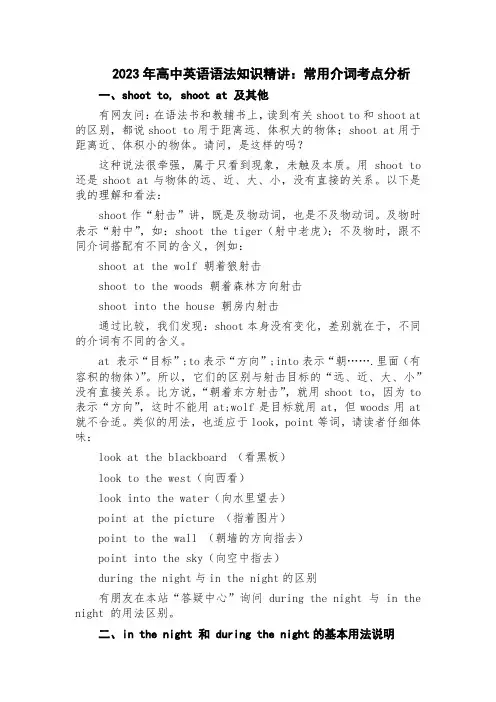
2023年高中英语语法知识精讲:常用介词考点分析一、shoot to, shoot at 及其他有网友问:在语法书和教辅书上,读到有关shoot to和shoot at 的区别,都说shoot to用于距离远、体积大的物体;shoot at用于距离近、体积小的物体。
请问,是这样的吗?这种说法很牵强,属于只看到现象,未触及本质。
用shoot to 还是shoot at与物体的远、近、大、小,没有直接的关系。
以下是我的理解和看法:shoot作“射击”讲,既是及物动词,也是不及物动词。
及物时表示“射中”,如:shoot the tiger(射中老虎);不及物时,跟不同介词搭配有不同的含义,例如:shoot at the wolf 朝着狼射击shoot to the woods 朝着森林方向射击shoot into the house 朝房内射击通过比较,我们发现:shoot本身没有变化,差别就在于,不同的介词有不同的含义。
at 表示“目标”;to表示“方向”;into表示“朝…….里面(有容积的物体)”。
所以,它们的区别与射击目标的“远、近、大、小”没有直接关系。
比方说,“朝着东方射击”,就用shoot to,因为to 表示“方向”,这时不能用at;wolf是目标就用at,但woods用at 就不合适。
类似的用法,也适应于look,point等词,请读者仔细体味:look at the blackboard (看黑板)look to the west(向西看)look into the water(向水里望去)point at the picture (指着图片)point to the wall (朝墙的方向指去)point into the sky(向空中指去)during the night与in the night的区别有朋友在本站“答疑中心”询问 during the night 与 in the night 的用法区别。
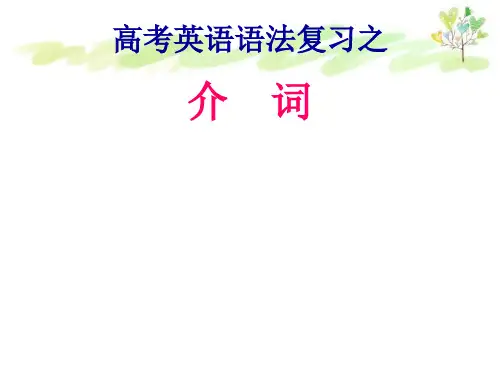
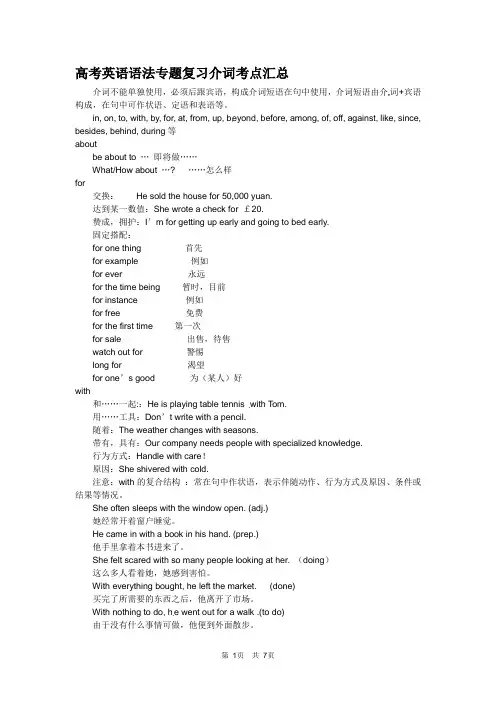
高考英语语法专题复习介词考点汇总介词不能单独使用,必须后跟宾语,构成介词短语在句中使用,介词短语由介词+宾语构成,在句中可作状语、定语和表语等。
in, on, to, with, by, for, at, from, up, beyond, before, among, of, off, against, like, since, besides, behind, during等aboutbe about to …即将做……What/How about …?……怎么样for交换:He sold the house for 50,000 yuan.达到某一数值:She wrote a check for £20.赞成,拥护:I’m for getting up early and going to bed early.固定搭配:for one thing首先for example例如for ever永远for the time being 暂时,目前for instance 例如for free免费for the first time 第一次for sale出售,待售watch out for警惕long for 渴望for one’s good为(某人)好with和……一起::He is playing table tennis with Tom.用……工具:Don’t write with a pencil.随着:The weather changes with seasons.带有,具有:Our company needs people with specialized knowledge.行为方式:Handle with care!原因:She shivered with cold.注意:with的复合结构:常在句中作状语,表示伴随动作、行为方式及原因、条件或结果等情况。
She often sleeps with the window open. (adj.)她经常开着窗户睡觉。
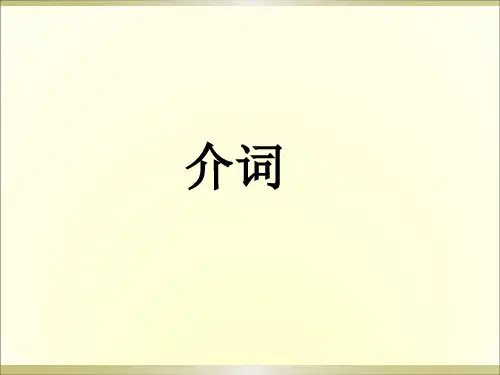
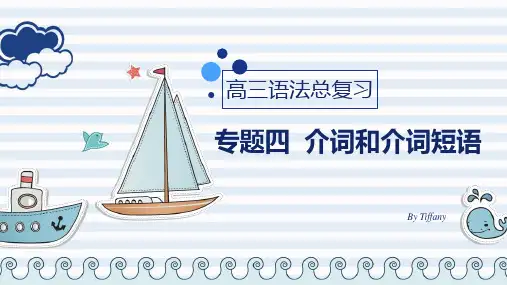
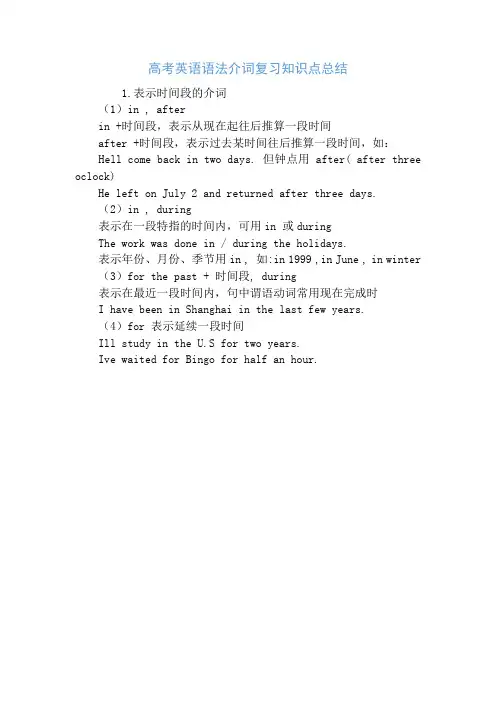
高考英语语法介词复习知识点总结
1.表示时间段的介词
(1)in , after
in +时间段,表示从现在起往后推算一段时间
after +时间段,表示过去某时间往后推算一段时间,如:
Hell come back in two days. 但钟点用after( after three oclock)
He left on July 2 and returned after three days.
(2)in , during
表示在一段特指的时间内,可用in 或during
The work was done in / during the holidays.
表示年份、月份、季节用in , 如:in 1999 ,in June , in winter (3)for the past + 时间段, during
表示在最近一段时间内,句中谓语动词常用现在完成时
I have been in Shanghai in the last few years.
(4)for 表示延续一段时间
Ill study in the U.S for two years.
Ive waited for Bingo for half an hour.。

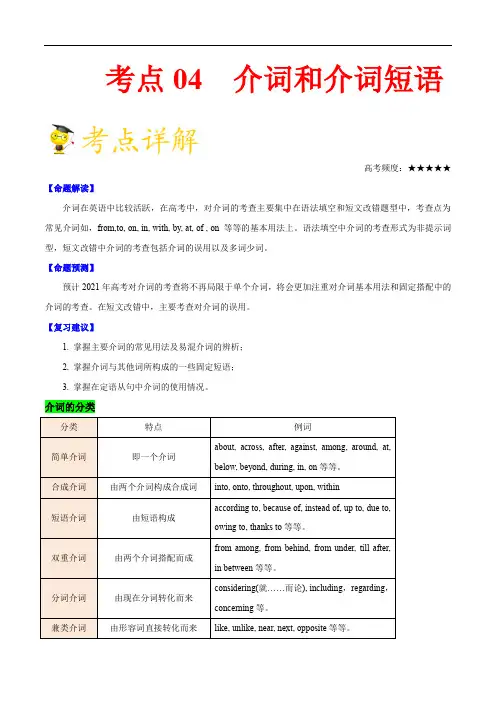
考点04 介词和介词短语高考频度:★★★★★【命题解读】介词在英语中比较活跃,在高考中,对介词的考查主要集中在语法填空和短文改错题型中,考查点为常见介词如,from,to, on, in, with, by, at, of , on 等等的基本用法上。
语法填空中介词的考查形式为非提示词型,短文改错中介词的考查包括介词的误用以及多词少词。
【命题预测】预计2021年高考对介词的考查将不再局限于单个介词,将会更加注重对介词基本用法和固定搭配中的介词的考查。
在短文改错中,主要考查对介词的误用。
【复习建议】1. 掌握主要介词的常见用法及易混介词的辨析;2. 掌握介词与其他词所构成的一些固定短语;3. 掌握在定语从句中介词的使用情况。
介词的分类考向①介词短语的功能介词不能独立在句中做成份,介词后必须与名词、代词、或动名词构成介词短语在句中充当一个成分,表示人、物、事件等与其它人、物、事件等之间的关系。
考向②常考介词的辨析介词是英语中最活跃的词类之一,使用频率相当高,其用法跟冠词一样复杂。
但根据近年来高考命题的情况来看,考生需要掌握以下内容。
1.表示相同或相似概念的介词(短语)的区别①at 8 o’clock, at noon②in the 1990s, in January③on Monday, on a warm morningon the①The lamp stands in the corner of theroom.②I me t with him at the street corner.③He sat on the corner of the table.besidesexceptbutexcept for1.(2020·新课标I卷短文改错)After that I poured oil into a pan and turned off the stove,I waited patiently unless the oil was hot.【答案】将off改为on【解析】考查介词。
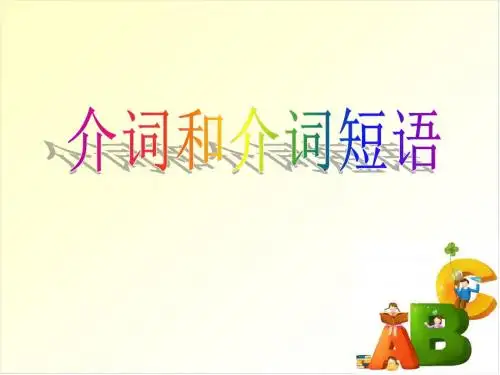
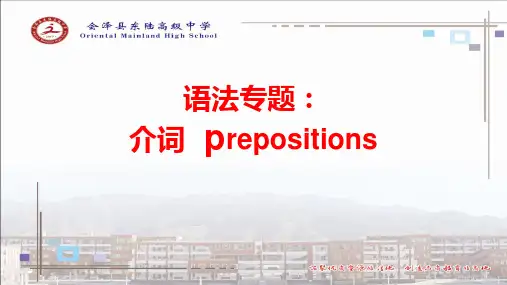
介词考点归纳语法填空对介词的考查点是:1、常见介词的基本用法;2、与介词构成的一些习惯搭配。
例如:I didn’t want to be laughed at for talking to him but I didn’t like leaving him 23 his own either.(2011,广东)一、介词的分类1.按结构分类from behind until after since before2.按意义分类(1)表示地点、方位的介词: _____________________________________________________①We’ll meet each other _____ the bus stop.②Mr. White lived ______ Hong Kong for 20 years.Shandong Province lies _______ the east of China.③The book you want is _____ the shelf.Mongolia lies ______ the north of China.Wuhan is located ______ the Yangtze River.④Shandong Province lies ______ the southeast of Hebei Province.⑤There is a bridge ______ the river.She put her letter _______ the pillow.The plane is flying ________ our heads.(2)表示时间的介词: _______________________________________________________________①______ noon; _______ night; _______ midnight; ______ dawn; _______ daybreak; ______ dusk;_____ sunrise; _______ sunset; ______ 6:35②_____ the Qin Dynasty; _______ the 1980s; ______ October; _____ the eveningI’ll be back ______ an hour.My father will be back ________ 5 o’clock.My mother came back 3 days ______.③______ National Day; ______ a rainy day; ______ Monday morning; ______ Thursday; _____ December 23rd; _______ the afternoon of January 22nd; ______ the eve of victory④______ the time he was five, he had learned 500 Chinese characters.He had collected 3000 stamps ______ last month.⑤Mr. Brown has lived in the countryside ______ almost fifteen years after his retirement.⑥We have lessons _______ 6:30 to 22:30 every day.⑦Linda has been doing her homework ______ 7 o’clock.(3)表示方式的介词: __________________________________________________①She cut the apple into four equal parts ______ a knife.We see ______ our eyes, hear _______ our ears, and walk ______ our legs.②He made a living ______ fishing.③You must write your composition _____ black ink.They can communicate with each other ______ English.固定结构:“用……方法”:________ this/that/the same way________ means of________ this/that means________ this/that method(4)表示交通/旅行的方式: _______________________________________________①______ water; ______ land; _______ air; ______ rail; _______ sea; ______ taxi; ______ spaceship;_____ plane; _______ train; ______ ship; _______ boat; _____ bike; ______ bus②I came here ____ a taxi.They left ______ a early train.He usually goes to school ______ his own bike, but today he went to school ______ foot.(5)表示“在……之间”的介词This secret is only __________ you and me.What’s the difference __________ the two words?We visited a small village __________ mountains last month.He divided his money __________ John, Helen and his nephew.(注:当句中出现divide, share等词时,如果后面跟着几个单数名词,则用between;如果后面是复数名词,between和among都可以。
高考高中英语核心语法详解介词第一节基础知识1. 定义从字“介”上理解,介词是一种媒介,是桥梁,主要用于交代其所连接的前后两部分的关系。
从狭义角度讲,介词也可以说是动词的替身。
介词的用法就是放在名词前面、与名词(称为它的宾语)共同构成一个意义单元、称为介宾短语,当作修饰语使用。
介宾短语可以当形容词或副词使用。
2.介词的分类依据介词后面是否有宾语,分为介系词和介副词。
3.介系词主要是指后面可以接宾语的介词,由此构成介宾短语,介词后面的宾语主要是以名词性质的词来做。
例:in trouble 陷入麻烦on the table 在桌子上Bob is in trouble. 鲍勃陷入麻烦。
A red apple is on the table. 一个红苹果放在桌子上了。
4.介副词后面没有宾语,而是直接当副词使用。
Come in. 进来!The soldier stood up. 那名士兵站起来了。
5. 介副词和介词共同使用Mary went down to the basement. 玛丽去了地下室。
down 是介副词,后面没有宾语、直接修饰动词went;to 是介系词,后接名词词组the basement 当宾语、构成一个介词词组to the basement;went 看作不及物动词,后接介词to,再加宾语the basement;He has gone over to your office.over 是介副词,直接修饰动词has gone;to 是介词,后接名词词组your office 当宾语,构成一个介词词组to your office;gone看作不及物动词,后接介词to,再加宾语your office;第二节介系词在短语层面的应用介系词加宾语构成介宾短语后,主要出现在后修饰位置,其作用是交代中心词与其后的宾语之间的关系。
此时介宾短语也可视为形容词的性质。
例:a.2000 entry into the World Trade Organization2000年加入世贸b.an important earner of foreign exchange 赚取外汇的重要来源c. a boom in exports 出口增长第三节介系词在句子层面的应用1. 前状/后状:With the warm weather, the trees grow very well. 天气暖和,树木生长的很好!Kill two birds with one stone. 一石二鸟/一举两得。
高考英语语法填空常考介词在高考英语语法填空中,介词是常考点之一,这些介词考点常常是考生们易错易混淆的地方。
下面就对每个介词考点进行详细的解释和扩充,帮助考生们更好地掌握这些介词的使用规则。
1. 表示时间的介词:at:常用于表示具体的时间点,如at 8 o'clock,at noon等。
on:用于表示在某一天或具体的某一天的上下午,如on Monday,on the afternoon of July 4th等。
in:用于表示在某个时间段内,如in the morning,in the afternoon等。
at the beginning of:在...的开始。
at the end of:在...的结尾。
in the middle of:在...的中间。
during:在...期间。
2. 表示地点的介词:at:用于表示在某个具体的地点或位置,如at the bus stop,at home等。
in:用于表示在某个建筑物、城市或较大的地理区域之内,如in the classroom,in Beijing等。
on:用于表示在某物的表面或与某物接触的表面,如on the table,on the ground等。
near:在...附近。
by:在...旁边。
between:在...之间。
in front of:在...的前面。
behind:在...的后面。
3. 表示方式的介词:by:用于表示通过某种方式或手段,如by bus,by phone等。
in:用于表示以某种状态或形式存在,如in English,in writing等。
on:用于表示在某种物体或表面上,如on the wall,on the table等。
4. 表示原因的介词:because of:由于...的原因。
due to:由于...的缘故。
这两个介词都可以用来表示原因,但略有区别。
because of更强调直接原因,而due to更强调因果关系。
一介词和介词短语介词和介词短语的核心考点介词是虚词,不能单独作句子成分,必须与名词、代词(或相当于名词的其他词类、短语或从句等)构成介词短语,在句中充当一个成分。
介词分为:简单介词,如at,in,for 等;合成介词,如within,inside,onto,throughout等;短语介词,如according to,out of,because of,by means of,in spite of,instead of等;双重介词,如from behind/above/under,until after等;分词介词,如considering,including,judging (from/by) 等。
1.介词搭配(1)“动词+介词”搭配:注意特定搭配与同一介词与多个动词搭配意义不同的情况。
①rob sb. of sth. /clear the road of snow(表示“夺去、除去”意义的动词与of 连用)②supply us with food/fill the glass with wine(表示“供给”意义的动词与with 连用)③make a desk of wood/mak e bread from flour/make the material into a coat(表示“制作、制造”意义的动词与of,from,into连用)④介词+the+部位与动词的关系(=动词+sb. ’s+部位,可换用)strike him on the head(表示“击;拍;碰;摸”意义的动词与on连用)catch him by the arm(表示“抓;拉;拿;扯”意义的动词与by连用)hit the boy in the face(表示“肚;胸;眼;脸”等人体前部的器官名词与in连用)⑤prevent(stop,keep)sb. from doing sth. (表示“阻止,禁止”意义的动词与from 连用)⑥persuade(advise,warn)sb. into doing sth. (表示“说服;建议;警告”意义的动词与into连用)⑦buy(leave,get,win,gain,lose) sth. for sb. (表示“得失”意义的动词与for 连用)⑧tell(show,teach,sing,write,read) sth. to sb. (表示“告知”意义的动词与to连用)⑨give(allow,promise,pass,hand) sth. to sb. (表示“授予”意义的动词与to 连用)注意:⑦⑧⑨可换成buy sb. sth. ,tell sb. sth. ,give sb. sth. 双宾结构。
高考英语语法介词考点介词是一种用来表示词与词、词与句之间的关系的虚词,在句中不能单独作句子成分。
介词后面一般有名词、代词或相当于名词的其他词类,短语或从句作它的宾语。
介词和它的宾语构成介词词组,在句中作状语、表语、定语或宾语补足语。
介词可分为时间介词、地点介词、方式介词、原因介词和其他介词。
①Nothing in the world could live without air or water.(状语)②This machine is in good condition.(表语)③Where is the key to my bike?(定语)④She always thinks herself above others.(宾补)一、介词的分类(1)从用法分类介词类型例词例句表示方位at, before, behind, below, etc.There must be somethingbehind it.表示时间about, after, at, before, by, etc. He came home after 3 days.表示原因、目的for, with, from, etc. He died from cancer.表示对于to, for, over, at, with, etc.The book is really difficult forme.表示手段、方式by, in, with, etc.I will defend the motherlandwith my life.表示除去but, besides, except, etc.We all went to the supermarketexcept Tom.表示比较as, like, above, over, than, etc. They united as one man.表示结果to, with, without, etc. Man can’t live without water.(2)从结构分类介词分类构成例词简单介词只有单独一个词的介词after, at, on, in, during, since, till, across, over, through, past, near, to, above, by,for, down, from, of, off, behind, below,beneath, beside, between, beyond, up,with, about, against, along, among,around, etc.复合介词由两个单词合成的介词 into, inside, onto, outside, throughout, towards, upon, within, without, etc. 形容词,分词或副词+介词according to, away from, down to, inside of, near to, opposite to, owing to, etc. 连词+介词as for, as to, because of, etc. 介词+介词(又称双重介词)from among, from behind, from under, till after, in between, etc. 介词+名词+介词 by means of, in front of, in spite of, on account of, withregard to, etc.短语介词 其他thanks to, etc.分词concerning, considering, including, regarding, etc. 形容词或副词 like, near, opposite, round, next, etc. 连词than, but(除……之外), etc.由其他词类转用名词despite(不顾;不管), etc.【考点一】考查with/without复合结构介词with/without+名词/代词+形容词/副词/介词短语/动词不定式/分词(分词可以是现在分词,也可以是过去分词)在句中表状态或说明背景情况,常作伴随、方式、原因、条件等状语。
With all the things she needed bought, she went home happily.Possibly this person died without anyone knowing where the coins were hidden.单项填空①It was a pity that the great writer died _____ his works unfinished.A. forB. withC. fromD. of解析:选B。
考查with复合结构。
works 与unfinish之间为动宾关系,所以用过去分词表示被动。
如果名词或代词与后面的动词是主谓关系,则用现在分词表示主动。
【考点二】考查工具、手段、方式介词(1)by, in, on三词都可表示旅行的方式①不涉及交通工具的名词时用by,名词前不加冠词。
如by sea, by water, by land, by rail, by air等。
②涉及交通工具的名词时用by,名词须用单数形式,前面不加冠词或任何修饰语。
如by bike, by taxi, by plane, by ship/boat, by train, by spaceship等。
③当旅行方式涉及确定特指的交通工具时,用on或in,名词前加冠词、物主代词、指示代词等修饰语。
如travel to New York in this plane,leave on an early train,go to school on my bike等。
注意:步行、骑马、骑骆驼均用on。
如on foot,on horseback,on a horse,on the camel。
(2)with, by, in三词均意为“用”,表示行为的工具、手段或方式。
①with用于有形的工具或身体某些器官之前,其后的名词多被冠词、物主代词等修饰。
They are digging with a pick/spade.We see with our eyes, hear with our ears, and walk with our legs.②by, in, on, over, through等介词多用于无形的工具或方式手段之前。
如by hand, in ink, on the telephone, over the radio, through the telescope等。
注意:①使用语言、原料、材料时,用in表示,如in English/Japanese;in blue ink等。
②表达“用……方法/式”时,所用介词有:in this/that/the same way,by means of,by this/that means,with this/that method等。
【考点三】考查of+抽象名词的用法“of+抽象名词”的用法与形容词相同,在句中可作表语、定语、补语。
of+great/much +抽象名词=very+名词的形容词形式of+no+抽象名词=not+名词的形容词形式It is of great value.=It is very valuable.It is of no use.=It is useless.The camel is of great help to the Arab.=The camel is very helpful to the Arab.【考点四】考查表示程度的介词by, to, beyondby 表示“增加了……”;to表示“增加到……”;beyond表示“范围, 限度超出”。
This new model of car is so expensive that it is beyond the reach of those with average incomes.单项填空②Sorry, Madam. You’d better come tomorrow because it’s ______ the visiting hours.A. duringB. atC. beyondD. before解析:选C。
考查介词的用法。
句意为:对不起,女士,你最好明天来,因为已经过了开放时间了。
beyond(时间)晚于,迟于。
【考点五】考查介词but的固定搭配have no choice but to do只得做某事;can’t help but do不得不做……;can’t but do不得不只能;can’t choose but do只得做某事;but for要不是……。
I have no choice but to accept his conditions.There was no taxi that day, I couldn’t choose but stay there foranother night.【考点六】考查to one’s+情感类名词to 与情感类名词连用,表示“某人因某事的发生而唤起其内心的某种情感”。
常见的结构有:to+one’s+delight/surprise/horror/sorrow/joy/regret=to the delight/surprise/horror/sorrow/joy/regret of sb.。
这种结构表示结果,用作状语,通常置于句首,也可置于句中或句末。
若要加强该结构的语气,有两种方式:①在名词前加great, deep等形容词修饰;②在整个短语前加副词greatly, much等修饰。
To his disappointment, he failed again.【考点七】考查名词与to构成的固定搭配key, approach, solution, answer, entrance, visit, attitude等与to构成固定搭配:the key/approach/solution/answer/entrance/visit/attitude to...。
It is said that they have adopted a new approach to teaching English.【考点八】考查介词by的用法(1)by+地点名词。
表示方位,意为“在……旁边”。
注意:表示“从……旁边经过”时,多与动词go/walk/pass等词连用。